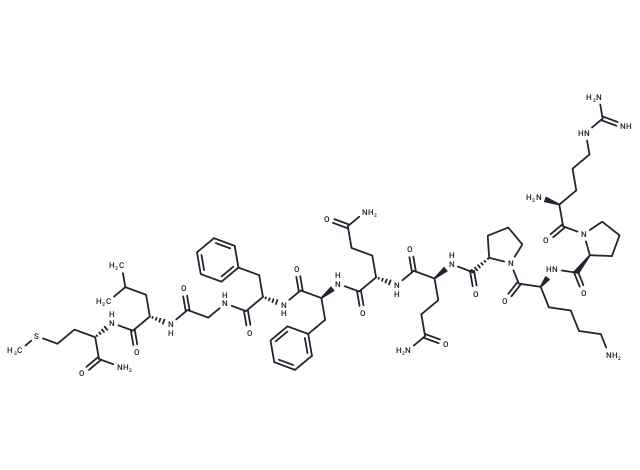Shopping Cart
Remove All Your shopping cart is currently empty
Your shopping cart is currently empty
Substance P (Neurokinin P) (SP) is an undecapeptide (a peptide composed of a chain of 11 amino acid residues) member of the tachykinin neuropeptide family.

| Pack Size | Price | USA Warehouse | Global Warehouse | Quantity |
|---|---|---|---|---|
| 1 mg | $52 | In Stock | - | |
| 5 mg | $118 | In Stock | - | |
| 10 mg | $188 | In Stock | - | |
| 25 mg | $400 | In Stock | - | |
| 50 mg | $595 | In Stock | - | |
| 100 mg | $849 | Inquiry | Inquiry | |
| 1 mL x 10 mM (in DMSO) | $313 | In Stock | In Stock |
| Description | Substance P (Neurokinin P) (SP) is an undecapeptide (a peptide composed of a chain of 11 amino acid residues) member of the tachykinin neuropeptide family. |
| In vitro | The process involves the desensitization and resensitization of neuropeptide substance P (SP) through the neurokinin 1 receptor (NK1-R), which may relate to the endocytosis and recycling of NK1-R. Both SP and NK1-R are internalized into clathrin-immunoreactive vesicles and subsequently segregated into distinct compartments. Initially, SP remains intact on the cell surface and in early endosomes but gradually degrades in perinuclear vesicles. SP triggers the clathrin-dependent internalization of NK1-R. Within acidified endosomes, the SP/NK1-R complex disassociates, leading to the degradation of SP while NK1-R is recycled back to the cell surface. This mechanism of SP-induced NK1-R internalization is observed in transfected epithelial cells[1]. |
| Synonyms | Neurokinin P |
| Molecular Weight | 1347.63 |
| Formula | C63H98N18O13S |
| Cas No. | 33507-63-0 |
| Smiles | CSCC[C@H](NC(=O)[C@H](CC(C)C)NC(=O)CNC(=O)[C@H](Cc1ccccc1)NC(=O)[C@H](Cc1ccccc1)NC(=O)[C@H](CCC(N)=O)NC(=O)[C@H](CCC(N)=O)NC(=O)[C@@H]1CCCN1C(=O)[C@H](CCCCN)NC(=O)[C@@H]1CCCN1C(=O)[C@@H](N)CCCNC(N)=N)C(N)=O |
| Relative Density. | 1.42g/cm3 |
| Color | White |
| Appearance | Solid |
| Sequence | Arg-Pro-Lys-Pro-Gln-Gln-Phe-Phe-Gly-Leu-Met-NH2 |
| Sequence Short | RPKPQQFFGLM-NH2 |
| Storage | keep away from moisture,store at low temperature | Powder: -20°C for 3 years | In solvent: -80°C for 1 year | Shipping with blue ice/Shipping at ambient temperature. | ||||||||||||||||||||
| Solubility Information | DMSO: 10 mM, Sonication is recommended. | ||||||||||||||||||||
| In Vivo Formulation | 10% DMSO+40% PEG300+5% Tween 80+45% Saline: 2 mg/mL (1.48 mM), Sonication is recommended. Please add the solvents sequentially, clarifying the solution as much as possible before adding the next one. Dissolve by heating and/or sonication if necessary. Working solution is recommended to be prepared and used immediately. The formulation provided above is for reference purposes only. In vivo formulations may vary and should be modified based on specific experimental conditions. | ||||||||||||||||||||
Solution Preparation Table | |||||||||||||||||||||
DMSO
| |||||||||||||||||||||
| Size | Quantity | Unit Price | Amount | Operation |
|---|

Copyright © 2015-2025 TargetMol Chemicals Inc. All Rights Reserved.